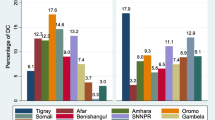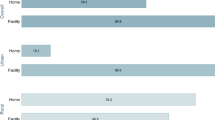Abstract
Institutional delivery is an important factor associated with reduced maternal mortality rate (MMR). MMR in Haiti is high (350 per 100,000) and institutional delivery is low—just over 25 % of women delivered at a health facility in 2010. There also exists substantial rural–urban disparity in delivery with more hospital deliveries in urban than in rural areas. We aimed to study the prevalence and determinants of institutional delivery in a sample of women of childbearing age in rural Haiti. The study took place in Fond des Blancs and Villa, as part of a baseline assessment undertaken prior to implementation of a maternal, child health, nutrition, and water and sanitation program. From October to November 2011, women 15–49 years old (N = 575) were selected using a cross-sectional two-stage sampling strategy. We used descriptive and multivariate logistic regression analyses to assess the prevalence of and factors associated with institutional delivery. The prevalence of institutional delivery was 45.4 %; a rate higher than the national average of 25 %. In adjusted analyses, correlates of institutional delivery were younger maternal age (25 years and younger) (OR 1.82; CI 1.15, 2.90; P = 0.0112), antenatal care receipt (OR 3.70; CI 1.84, 7.43; P = 0.0003) and those who were poor according to our poverty index score classification (OR 2.04; CI 1.13, 3.69; P = 0.0187). This study shows that increased hospital delivery is likely explained by accessibility to antenatal care. Programs that improve access to antenatal care, with concurrent efforts to address structural inequalities that drive socio-economic deprivation, are likely critical to increasing institutional delivery.
Similar content being viewed by others
References
United Nations Millennium Development Goals. http://www.un.org/millenniumgoals/maternal.shtml. Accessed November 15, 2013.
WHO | Maternal mortality. WHO. http://www.who.int/mediacentre/factsheets/fs348/en/. Accessed March 18, 2014.
UNICEF—Millennium Development Goals. http://www.unicef.org/mdg/index_maternalhealth.htm. Accessed March 18, 2014.
WHO | Antenatal care (at least 4 visits). WHO. http://www.who.int/gho/urban_health/services/antenatal_care_text/en/. Accessed May 22, 2013.
Gabrysch, S., & Campbell, O. M. (2009). Still too far to walk: Literature review of the determinants of delivery service use. BMC Pregnancy Childbirth, 9, 34. doi:10.1186/1471-2393-9-34.
Mengesha, Z. B., Biks, G. A., Ayele, T. A., Tessema, G. A., & Koye, D. N. (2013). Determinants of skilled attendance for delivery in Northwest Ethiopia: A community based nested case control study. BMC Public Health, 13, 130. doi:10.1186/1471-2458-13-130.
WHO | Trends in maternal mortality: 1990 to 2010. WHO. http://www.who.int/reproductivehealth/publications/monitoring/9789241503631/en/. Accessed April 29, 2014.
UNICEF—At a glance: Haiti—Statistics. UNICEF. http://www.unicef.org/infobycountry/haiti_statistics.html#106. Accessed October 20, 2013.
Thaddeus, S., & Maine, D. (1994). Too far to walk: Maternal mortality in context. Social Science and Medicine, 38(8), 1091–1110. doi:10.1016/0277-9536(94)90226-7.
Barber, S. (2006). Does the quality of prenatal care matter in promoting skilled institutional delivery? A study in rural Mexico. Maternal and Child Health Journal, 10(5), 419–425. doi:10.1007/s10995-006-0079-x.
Gage, A. J., & Guirlène Calixte, M. (2006). Effects of the physical accessibility of maternal health services on their use in rural Haiti. Population Studies, 60(3), 271–288. doi:10.1080/00324720600895934.
Ayoya MA, Ngnie-Teta I, Séraphin MN, et al. (2013). Prevalence and risk factors of anemia among children 6–59 months old in Haiti. Anemia, 2013, 502968. doi:10.1155/2013/502968.
Institut Haitians de Statistiques et d’Informatiques. Population Totale, Population de 18 ans et plus Menages et Densites Estimes en 2009 (2012). http://www.ihsi.ht/pdf/projection/DOC_POPTLE18_MENEST2012.pdf. Accessed March 17, 2014.
Acknowledgments
This study was funded by a grant to St. Boniface Haiti Foundation from UNICEF Haiti. The views expressed herein are those of the authors and do not necessarily reflect the official policy or position of St. Boniface Haiti Foundation and UNICEF. The authors would like to thank Dr. Linda Cottler and the Writing Circle class at the Department of Epidemiology, University of Florida for constructive comments on earlier drafts of the manuscript.
Author information
Authors and Affiliations
Corresponding author
Rights and permissions
About this article
Cite this article
Séraphin, M.N., Ngnie-Teta, I., Ayoya, M.A. et al. Determinants of Institutional Delivery Among Women of Childbearing Age in Rural Haiti. Matern Child Health J 19, 1400–1407 (2015). https://doi.org/10.1007/s10995-014-1646-1
Published:
Issue Date:
DOI: https://doi.org/10.1007/s10995-014-1646-1




